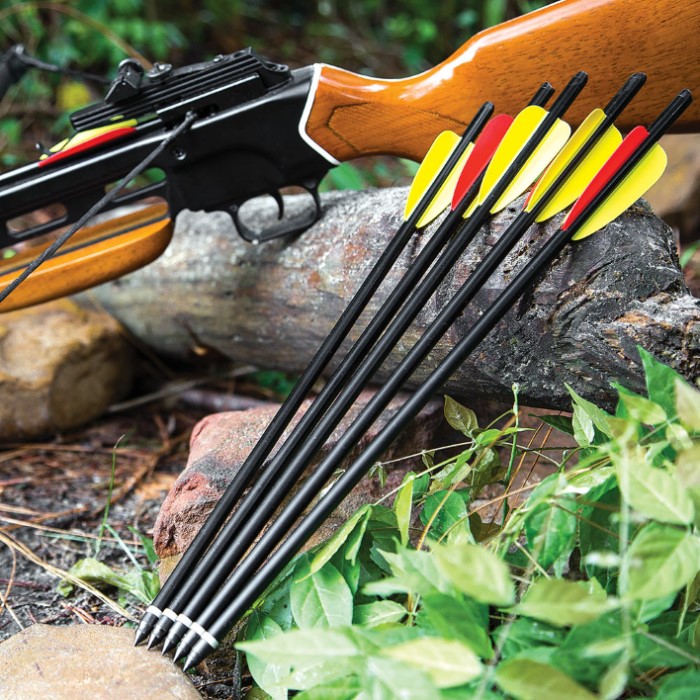
This same strength is also what can snap an arrow after being shot, which can lead to an unsuccessful harvest. The power is so strong that it has caused many injuries to hunters. For example, when turkey hunting, if one has ever tried to pick up a gobbler a few seconds after they have made their shot, they know the power that a gobbler has when their wings hit the hunter that is trying to pick them up. This theory goes for turkeys as well as big game animals. The most common reason is because lighter arrows tend to not be as accurate when shot with more force and in my own personal experience, a heavier arrow seems to have better knockdown. When using modern crossbows that are capable of shooting 350+ FPS, a heavier arrow is always a good idea. This is where I confirmed that I needed to eliminate lighter weight arrows and choose the heavier arrows, simply because they had better results. When shooting, I will shoot at multiple distances, angles, and even elevations from the ground as well as in a treestand to try and recreate every possible hunting scenario. Even though I matched up a hard shooting crossbow with heavy arrows, I still shot multiple arrows at a block style target, as well as a Delta McKenzie 3D Deer Target to figure out how deep my arrow penetrated the targets, as well as how accurate of groups each one produced.

The old saying of “shoot what fits you and your equipment” is true. Since it is a harder shooting crossbow, I paired it up with the Easton FMJ crossbow arrows which are 22”, have a core diameter of 0.344, and have a GPI of 13.7. Recently I have been shooting the Ten Point Shadow NXT which is a crossbow capable of shooting speeds up to 380 FPS with up to 122 FP’s of kinetic energy. Choosing the proper weight and length is the first steps in proper arrow selection. Shooting an arrow that fits the hunters chosen weapon is crucial in success once ready to hunt. I have discovered when it comes to hunting turkeys or larger game such as deer or elk with a crossbow, it is not about faster speeds and longer shots as much as I first thought, instead it is about creating better penetration from heavier arrows instead of the traditional bolt that most crossbow hunters are accustomed to.įinding the right arrow for crossbow hunting can be like that of a long-distance firearm shooter finding the perfect load. Since that unsuccessful hunt, I have done research, tested for myself, as well as used in the field different types of equipment to make sure that I am able to make the deadliest shot possible, in hopes that I never experience an unsuccessful recovery again. It’s the worst feeling that a bowhunter can have, in not knowing if the gobbler survived and it makes one want to go home and regroup, studying what could have been changed to make the hunt successful. I found one small drop of blood, I never found my bolt as well as no other sign of a successful shot. It’s sad to say, but I was unsuccessful in recovering the gobbler on that hunt. On this particular hunt, I used a lightweight bolt because I wanted speed and distance out of my crossbow. Every bowhunter knows the doubts that run through one’s head when faced with the uncertainty in knowing if a clean harvest was made or not. After it disappeared, I was left questioning myself as to if I had made a good shot, perhaps I was seeing things and the bolt didn’t actually hit the gobbler. The gobbler didn’t fly, rather it quickly ran up a hill then entered the timber. The bolt flew so fast through the air that I almost missed witnessing it hit the gobbler behind the left wing. Once the gobbler came within 40 yards, I took aim through the scope of my crossbow and squeezed the trigger. Unfortunately, the scenario and the over confident way that I anticipated this hunt going, isn’t the way that it ended.

In my head I was thinking like every other beginning crossbow hunter, having no movement and being equipped with faster arrows would allow for shooting further than normal, basically this hunt was all but over, all that was left to do is to load this gobbler in my truck.

My intuition was on point, I could see a lone gobbler feeding down a fence row that led directly under my treestand. As a feeling arose that something was coming in from behind me, I slowly turned 180 degrees, being ever so cautious not to let the ladder stand that I was hunting in make any unwanted noise.


 0 kommentar(er)
0 kommentar(er)
